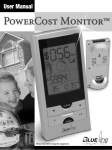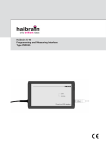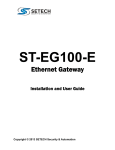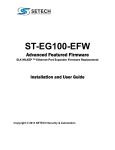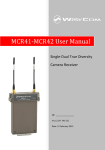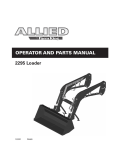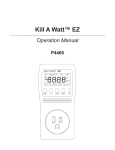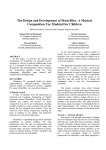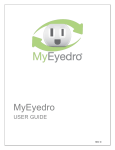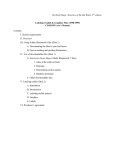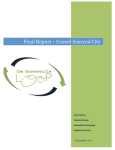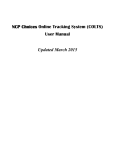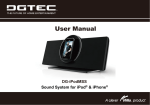Download Q8LCS - International Journal of Computer Applications
Transcript
International Journal of Computer Applications (0975 – 8887) Volume 14– No.8, February 2011 Q8LCS: A Mobile Application to Remotely Control Electricity Consumption Amir Zeid, Aisha AL-Kandari, Nadia AL-Fadhli, Amina AL-Anssari, ZibaEbrahimi American University of Kuwait Division of Sciences and Engineering ABSTRACT Electricity consumption and production are two of the main causes of energy crisis, global heating and environmental pollution. Many solutions have been introduced to lower electricity consumption. The main ideas to solve the problem include raising awareness, giving live feedback to users and providing some tools for them to control their homes remotely. In this paper, we introduce Q8LCS (Kuwait Lighting Control System) which is a mobile application that enables its users to control their regular home lighting and appliances via mobile phones. Through this application users can check if the lights/appliancesare on or off in each room. Also, users can know if someone is inside the room by motion sensors.In addition, users can switch the lights on or off using their mobile phones. General Terms his home lighting via mobile phone. Through this application he can check if the light is on or off in each room. Also, users can know if there is someone inside the room by the motion sensors and accordingly they can switch the light on or off. The rest of this paper is organized as follows: In section 2, the problem of electricity in Kuwait is introduced in more details. In section 3, the architecture of Q8LCS is introduced. In section 4, we show how to use Q8LCS. In sections 5 and 6, related work and future prospects are discussed. 500000 400000 Mobile applications. 300000 Keywords 200000 Electricity consumption monitor, web-services. 100000 Kuwait is one of the richest oil countries in the world. It has five power stations and a total electrical generation capacity of about 9.4 Giga watts (GW). Yet it faces a huge problem which is electricity shortage. According to the Global Virtual University (GVU) Kuwait's electricity usage per capita is one of the highest in the world, at roughly 14,000 kilowatt hours. This country of only 2.3 million residents reportedly is seventh in the world in terms of electricity consumption per capita. The chart below shows the electricity consumption increasing in Kuwait from 1985 to 2008 [1]. Overall, Kuwaiti power demand has been growing rapidly in recent years, and is expected to continue increasing at 7-9 percent a year in coming years. Mobile phones are very popular and essential in Kuwait. The number of mobile lines in Kuwait is almost equal to the population [2]. Most people use mobile phones instead of land lines. Using mobile phone applications is popular among different age groups. Q8LCS isa mobile application that enables the user to control 0 1985 1987 1989 1991 1993 1995 1997 1999 2001 2003 2005 2007 1. INTRODUCTION Figure 1. Electricity consumption in Kuwait 2. BACKGROUND 2.1 Current Situation in Kuwait Lights are the leading energy user in homes. According to the US Department of Energy, lights can consume 44% of all electricity or 29% of all energy used. People waste energy by using more light than they need, lighting empty rooms, and not using sunlight. This dilemma leads to the idea that can solve this problem which is the home automation system. Home automation is anything that gives remote access or automatic control of anything around the home. Many variables can be integrated into home automation, such as: lighting, climate control, control of doors, windows, audio, and security systems. Automation Systems 8 International Journal of Computer Applications (0975 – 8887) Volume 14– No.8, February 2011 have many types. In this project we are going to focus on lighting control systems. 3. Q8LCS DESIGN 3.1 Use Cases There is a dramatic increase on electricity consumption in Kuwait due to heavy construction and lack of awareness. Kuwait‟s energy consumption is 39.54 Billion KWh (2006 est.) while the production is 44.75 Billion KWh (2006 est.). Two years ago (2008) at least 14 fires in 14 months happened for main electricity generators in different areas of the country[4]. Figure 2 shows the major use-cases of Q8LCS. It depicts different users of the system and most of the crucial use cases. The nonfunctional requirements of the system includes reliability, security and user friendliness. The system has two main users: the regular user who can check the status of the rooms (whether lights are on/off and if the room is occupied). He can also turn lights/appliances on/off. The administrator can add more rooms to the house, Delete existing rooms and Edit room details (Name, and other details). The Administrator can add new users as well. 37% predicts that the electricity problem will get worse. 24% think that the actions taken by the ministry will not solve the current problems [4]. 2.2 Current Solutions Awareness campaigns “Tarsheed” was launched in to provide awareness for residents on how to reduce electricity and water consumption [4]. The campaign has a web-site and huge advertisements in the country. The campaign‟s budget was around $ 35,000,000; however, the outcomes of the campaign were not up to the expectations of the residents of Kuwait. As a matter of fact they were all wondering about the real benefits of the campaign [4]. Importing electricity from other gulf region countries is another option. Kuwait was aiming at importing electricity from Qatar in 2009. The solution is expensive and it leaves Kuwait dependent on Qatar‟s surplus of electricity, which is questionable under the current conditions of huge constructions in Qatar. Timed blackouts are one of the solutions. However, with Kuwait‟s climate this is not practical especially in summers. Actually people may die if electricity is cut during the summer. 2.3 Proposed Solution Q8LCS is part of a complete suite to handle electricity consumption. Electreduce [4] (the other component of the solution) is basically an electricity consumption monitor where the user can use his mobile phone to get real time data about his electricity consumption. Q8LCS on the other hand, provides a mobile application to control regular homes by turning the lights on and off via simple mobile interface. The two applications together, represent a complete solution that could be used to ultimately reduce electricity consumption. The main objective of the project is to lower energy consumption. Moreover, it adds great security features for homes. It gives homes a "lived in" look while you're away from home. The main applications and benefits of Q8LCS are: Lower electricity consumption. Turn normal house into a smart house. Make safe homes for people by avoiding accidental fires caused by electricity load. It could be used as a remote control for the handicapped people to control appliances and lights. Figure 2 Use Case Diagram of Q8LCS. 3.2 Architecture and Major Components Figure 3 depicts the overall architecture of Q8LCS. It consists mainly of 3 layers: the mobile interface layer, the database layer and the sensors and controllers layer. In this section, we will introduce the layers in more details. 9 International Journal of Computer Applications (0975 – 8887) Volume 14– No.8, February 2011 computer interface and transceiver offers the user improved control of their X10 modules. Mobile Interface Login Check Room Status Check Appliance/light Status Change Appliance/light Status Databases Connector Figure 4 depicts the complete functionality of the system. The flow of the system can be divided into three major stages: - Users Rooms - Command flow from mobile-to-PC via GPRS network. Command flow from PC to hardware digital circuitry via PC-parallel port. Interface of Home/Office Appliances with hardware digital circuitry via device controllers. Sensors Motion Sensor Receiver Controller Figure 3. Overall Architecture of Q8LCS The components are as follows: 3.2.1 Interface A Graphical User Interface will be presented as a top layer of Q8LCS. This component provides a user friendly user interface for the system. The user will have the ability to view his/her rooms and whether they are occupied or not. Also the user will be able to see if the lights are turned on or off and he/she can switch the lights on and off. Figure 4 The Control Flow Diagram. 3.2.2 Database A centralized database, accessed by administrators and implicitly by user-application is vital for both users and the Electricity supplier. All user information (login, password), is stored within the database. On the other hand, the rooms of each house will be stored in the database. Figure 5 shows the rest of the cycle: A remote interface running at the end mobile device which has the capabilities to get the status of the home/office lighting information. The end user can get the current status of the devices and also change and update their status. All of the commands will be generated by the end 3.2.3 Application-to-Database Connector The main purpose of the connector is to read from/write to the database, thus it provides a link between the application, the sensors and the databases. 3.2.4 Sensors Motion Detector: The Marmitek X10 Motion Detector PIR on sensing movement will send X10 signals by wireless to an X10 receiver. Controller: Marmitek X10 Appliance Module & Transmitter AWM2P (Micro Module) o X10 transmitter for two sequential X10 addresses (ON/OFF). o Two-way X10 communications. Receiver: Marmitek X10 - CM15 Pro Computer Interface & Transceiver TheMarmitek CM15Pro Figure 5 Transfer of command from mobile to PC. 10 International Journal of Computer Applications (0975 – 8887) Volume 14– No.8, February 2011 user„s mobile device and will reach the PC at home/office via GPRS network. Packets reached at the dedicated mobile device via GPRS network will be passed to the PC via Internet. At this stage decisions are made with accordance to the command received from end user mobile, after the decision is made the status information is modified and the status tables are updated at both ends. 3.3 Major Classes of Q8LCS Figure 6 shows the relationships among Q8LCS main classes. The House could be controlled by many authorized users. The main function of the connector is to update the appropriate databases according to the command it receives from the UI and the Receiver. Each Receiver is associated with both Motion Sensor and Controller. The Controller mainly turns appliances on/off while the Motion Sensor is triggered by movements in the room. Figure 7Sequence Diagram for motion detection. Figure 8 depicts the sequence diagram for a user turning the lights/appliance off. The user sends a command to the Receiver which in turn relays a command to the Controller. The controller sends a confirmation to the UI via the Receiver. Next the Connector will update the Rooms database with the current new status of the lights/appliance. Figure 8. Sequence Diagram for controlling room. Figure 6 Class Diagram of Q8LCS 4. USING Q8LCS Figure 7 shows a snapshot of the sequence diagram for motion detection. The motion sensor sends a signal to the Receiver which relays a signal to the Connector. The Connector updates the room status in the main database to be occupied. Figure 9 shows the home remote control application. Users can interact with their homes via the mobile application. Users can see a list of the rooms with radio buttons ticked on-off which indicates electricity usage in the room. Users can see a map of their homes with bulbs showing where lights are currently on. The users via the application can turn electricity on and off in the corresponding rooms. In addition, the user can view if the rooms are occupied or not. The motion sensor detects if any motion happens inside the room and updates the view on the mobile phone. The user can also view his electricity consumption charts. He can refer to consumption per room as well. 11 International Journal of Computer Applications (0975 – 8887) Volume 14– No.8, February 2011 6. CONCLUSION AND FUTURE WORK In this paper, we presented Q8LCS which is a mobile application that helps users to remotely control their appliances and lights. The ultimate goal is to raise awareness and to lower electricity consumption. It could also be used as a remote control for physically challenged people. The applicability of the system is open. It could be used in different countries for different purposes. We are planning to implement versions of the software for different mobile operating systems and platforms. We are in the process of adding water consumption and control to the project. The system will be used to experiment with in some homes and organizations in Kuwait. Then we will conduct a survey to see the actual change of electricity consumption on both individual and national levels. Figure 9. Q8LCS main interface 5. ASSESSMENTS AND SIMILAR WORK We conducted a survey in Kuwait to investigate the feasibility of developing the system. We gathered general information about the project through an online survey and interviews. Overall, the feedback was good and 75% of the survey takers agree that Q8LCS will help reduce electricity consumption in Kuwait and are also willing to use it in their homes. There are several products that target the same problem. Kill-awatt is an electricity consumption monitor that forecasts weekly consumption and cost. It can be connected to the level of one appliance at a time to know which costs more [5]. PowerCost Monitor is another electricity consumption monitor that tracks the current cost and the accumulative cost. It also has a feature to track the electricity consumption of appliances [6]. The Energy Detective (TED) is another real time electricity consumption monitor. The accuracy of TED is high since it refreshes every second. TED comes with PC software that allows user to view charts and compare between trends of using electricity [7]. The Owl Wireless Energy Monitoring Device has an additional feature which is showing the carbon dioxide emission per hour [8]. All of the presented solutions require separate hardware to monitor the electricity consumption while Q8LCS uses mobile phones as a tool control appliances remotely. MobiLinc Pro is an iPhone application. Its main functions help control all of lights, thermostats, devices, programs and irrigation system while on vacation or away from home [9].Cortexa'siPhone app gives access to all of the controls of users‟ home. Users can watch streaming cameras, turn your lights on or off, turn the thermostat up or down, arm the security, turn the whole-home audio on and much more right from your iPhone, iPod Touch and iPad [9]. 7. REFERENCES [1] “Electrical Statistics” Ministry of Electricity and Water, State of Kuwait. Accessed on February 10th, 2011. http://www.mew.gov.kw/en/?com=content&act =view&id=243 [2] “Media Statistics, Mobile phone subscribers in Kuwait” Nation Master. Accessed February 20th, 2011. http://www.nationmaster.com/time.php?stat= med_mob_pho_sub-media-mobile-phone-subscribers & country=ku-kuwait [3] “Tarsheed: The National project for energy conservation” Accessed February 20th, 2011 http://www.tarsheedq8.com/ [4] Amir Zeid, Ali Dashti, Ahmad Ashour, Abdelwahab AlAtiqi , Abdullah Al-Shaikh, Salman Al-Saffar, „ElectReduce: A Real Time Electricity Consumption Monitor Using Mobile Phones”, ISCA 25th INTERNATIONAL CONFERENCE ON COMPUTERS AND THEIR APPLICATIONS, USA, March 2010. [5] “Kill a Watt, Operation Manual” P3 International Corporation. Accessed February, 10th, 2011. http://www.p3international.com/manuals/p4460_manual.pd f (Accessed October 28th, 2009) [6] “TED-1000 User Manual “ The Energy Detective Accessed October 28th, 2009, http://www.theenergydetective.com/media/ted5000usermanual.pdf [7] “OWL Wireless Electricity Monitor” OWL Accessed October 28th, 2009, http://www.theowl.com/shop/index.php?target=products&p roduct_id=6 [8] “Home Control IPhone Applications” SmartHomeHome Automation Store. Accessed February 9th, 2011. http://www.smarthome.com/iphone_apps.html. 12





